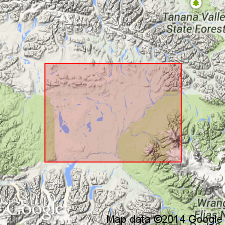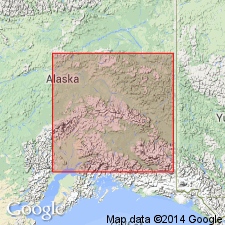
- Usage in publication:
-
- Jarvis Ash Bed
- Modifications:
-
- Named
- Dominant lithology:
-
- Ash
- AAPG geologic province:
-
- Alaska Southern region
Summary:
Unit is named the Jarvis Ash Bed. Bed is conformable with crude stratification of underlying and overlying silt layers. Ash is cream colored when dry and light gray when wet. Thickness is 1 to 3 cm. Near center of exposure, ash beds dip beneath tongue of gravel and is pinched off into isolated pods and lenses. Bed deposited between 4000 and 2000 years ago. Age is Holocene.
Source: GNU records (USGS DDS-6; Menlo GNULEX).

- Usage in publication:
-
- Jarvis Ash Bed*
- Modifications:
-
- Adopted
- Geochronologic dating
- AAPG geologic province:
-
- Alaska Southern region
Summary:
Jarvis Ash Bed of Reger and others (1964) is adopted. Consists of white vitric ash. Is 2 to 10 mm thick. Is [enclosed] within the Engineer Loess. Radiocarbon age of 4650 +/-250 yr B.P. was obtained on wood 27 cm below bed at type section and age of 1950 +/-150 yr B.P. was obtained a few mm above bed. Assigned Holocene age.
Source: GNU records (USGS DDS-6; Menlo GNULEX).
For more information, please contact Nancy Stamm, Geologic Names Committee Secretary.
Asterisk (*) indicates published by U.S. Geological Survey authors.
"No current usage" (†) implies that a name has been abandoned or has fallen into disuse. Former usage and, if known, replacement name given in parentheses ( ).
Slash (/) indicates name conflicts with nomenclatural guidelines (CSN, 1933; ACSN, 1961, 1970; NACSN, 1983, 2005, 2021). May be explained within brackets ([ ]).

